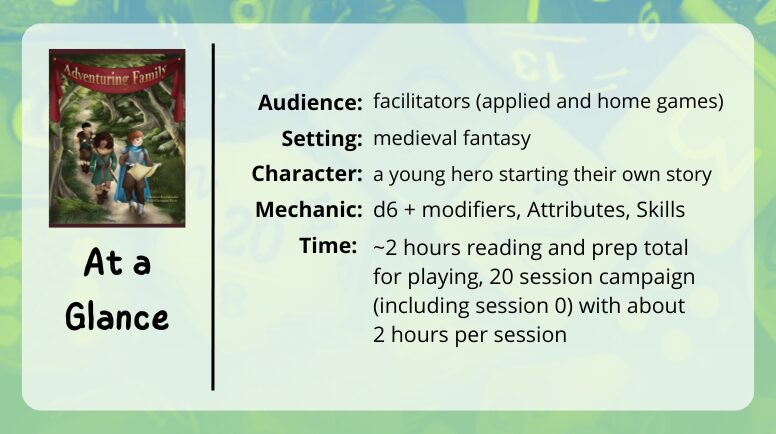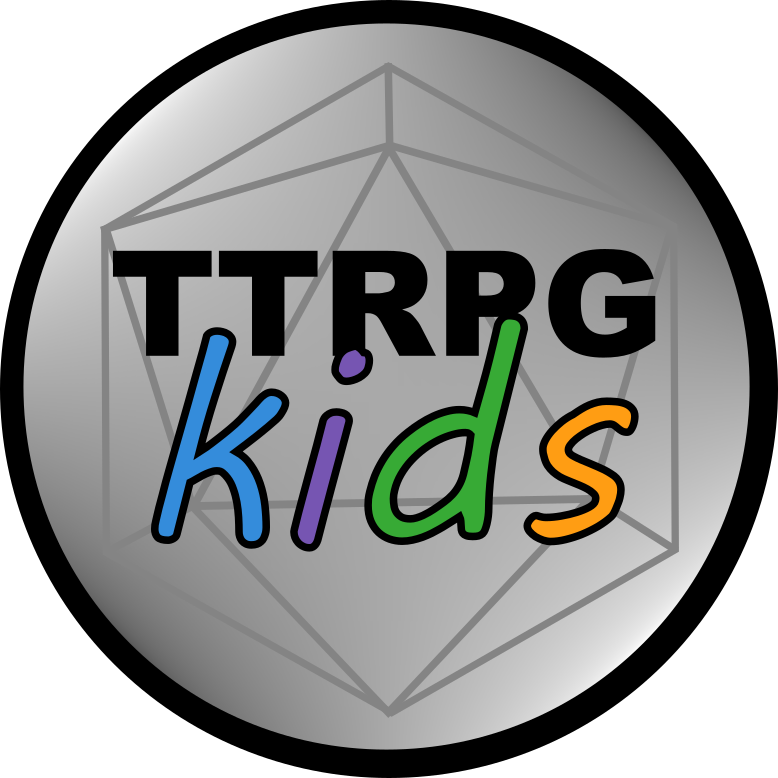Review of Adventuring Family – therapeutic family-focused gaming
*As a note, this book dives into both therapeutic and therapy focused elements. Therapeutic refers to something that can have a positive impact on one’s well-being (ex: creative time, yoga) whereas therapy is intentional time with a trained and licensed therapist to address specific concerns. The author’s intent with this book is for parents to use this for therapeutic purposes with their children. For addressing specific concerns (like ADHD, ASD, etc), attempting to enact therapy on your players when you are not trained or without their consent can have a detrimental impact on everyone involved. You should not attempt to enact therapy unless you are trained professional and have player consent to do so.
Jump to:

Target audience for Adventuring Family
Adventuring Family is aimed primarily at being a guide for parents to use with their kids and additionally for therapists to potentially use with patients. It also provides a game that can be used for all-ages.
For the home-game side, my advice is always to understand that you can include therapeutic elements in your game, but that you shouldn’t be “therapy-ing” players unless you are trained to do so (see note above). That said, this book offers a system and setting that can still be used for home games without doing active therapy but that can still provide some intrinsically therapeutic benefits and picking up tips to use while running the game (like adding tactile puzzles to help engage players).
On the applied gaming facilitator side, this book offers breakdowns of mental health conditions (like ADHD, ASD, etc) and how they can tie into gaming considerations along with explanations of how to use different elements of the pre-made world and story to start conversations about other psychiatric conditions like eating disorders and agoraphobia.
Regarding accessibility for players, the mechanics are easy to pick up and keep track of, requiring mostly 1d6 rolls plus 1-2 modifiers, and there’s even an alternative no dice option so that this won’t be a barrier to play. Character leveling includes comprehensible walkthroughs that gradually introduce players to how the game works. It’s also explained that facilitators should allow players multiple ways to solve challenges, including talking it out, so the story is flexible to both combat and non-combat approaches for being able to fit what your particular players want and can handle (i.e. some players do not want combat-combat-combat all the time, so the game does not require combat all the time).
Setting for Adventuring Family
Adventuring Family’s campaign is set in the world of Cosmos, a seemingly peaceful continent with a mysterious island off the coast to explore. In this world, magic is a thing of legends, but… Some of our heroes may be able to tap this power, especially as they reconnect with their ancestry.

Part of this game’s setting is that the characters are all part of a family descending from legendary heroes! Some of these heroic stories have been lost to time though, and finding family heirlooms to uncover some of this connection and history is an important part of the game.
The general world setting includes a 20 session campaign (including a session 0) to start you off, and it has several important NPCs and world details to flesh things out. Campaign sessions are broken down with easy to follow bullet points along with a short summary or advice on what to include in the session. I did really like seeing an outline here since this takes care of quite a bit of prep and has a pre-scaffolded story ready to use directly or to take as an example.
Your character in Adventuring Family
As I’ve mentioned before, your character is a descendant of a hero of old! However, your character is starting out as level 1. Through facing their own trials and learning about the world, they’ll grow to make their own story!

Characters are built from choosing a class (example: Bard) and style of play (examples: Merchant, Actor, Musician), which will then determine what Attributes and special bonuses you get on leveling up. This works REALLY well from a guided leveling standpoint to make sure characters are built to support the skills they learn.
A particular element of character creation that I really liked was that all characters start with their Attributes (STR, DEX, WIS, etc) at 0 for everything and only increase these as they level up. This means that at level 1, when you have no modifiers, players will learn most of the basics before modifiers get introduced at level 2 (yay for scaffolded play learning). This also gives a very logical reason for you all being at level 1 and shows how growth happens over time in a clear way through your stats.
Mechanics in Adventuring Family
There are a few core dice rolls in Adventuring Family, the first of which is the 1d6 + MODs. Most of your rolls for Skills (like Insight or Athletics) are going to be made by rolling 1d6, adding any applicable modifiers from your Attributes, and comparing your score to a challenge rating. This is super easy to follow from the character sheet AND it ends up doing something VERY interesting with the modifiers element as the game progresses.
Because Attributes start at 0 and level with your character (see previous section), by the time you’re at level 10, that character should have a +5 in their main Attributes. This means that for the hardest thing that requires a 6 or higher… you would automatically succeed if it is part of your specialty. It lets players just be super heroic at the end after having worked for a build up to this point. This is different from combat and contested rolls, so know that any final encounters can still be challenging, but for skills that you’ve been practicing? You ace those now as your reward for all that effort.

The game also includes percentage rolls for random situations that don’t entirely rely on character skill (like the odds of a magical device working or not). These rolls can also still be made with a 1d6, so the die stays consistent for all players throughout the game.
There is also a no-dice option for play in games where the dice could be prohibitive. In this case, it just uses the Attributes as kind of a passive modifier versus all checks – it’s an automatic success/fail based on the character’s stats, but players still have choice, and this can lead to strategizing between your players as they make sure they defer to the person best suited to the task at hand (great for taking turns and relying on each other).
Overall thoughts on Adventuring Family
I thought Adventuring Family had some good insights to offer in terms of running applied TTRPG sessions. I liked to see that there was a dice-less or super rules-lite option to fit player needs, and I liked that there was a per-session breakdown to show how to incorporate some of the book’s main goals (instead of leaving the reader to figure out how to piece the concepts together into a campaign) and also give an example for new GMs to follow and learn from.
Find a copy of Adventuring Family
You can find a copy of Adventuring Family on Amazon, and you can find the creator’s website here: https://adventuringfamilybooks.com/
And… if you liked this post, make sure to subscribe to the TTRPGkids monthly newsletter to stay up to date on the latest reviews, tips and tricks, game and podcast list updates, and more! Thank you for playing tabletop RPGs with your kids and sharing this awesome hobby with the next generation!



1 thought on “Review of Adventuring Family – therapeutic family-focused gaming”